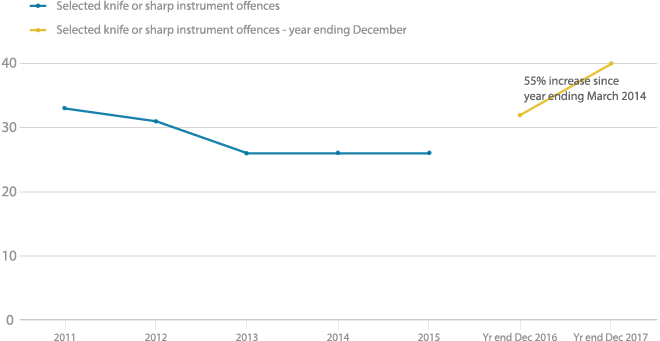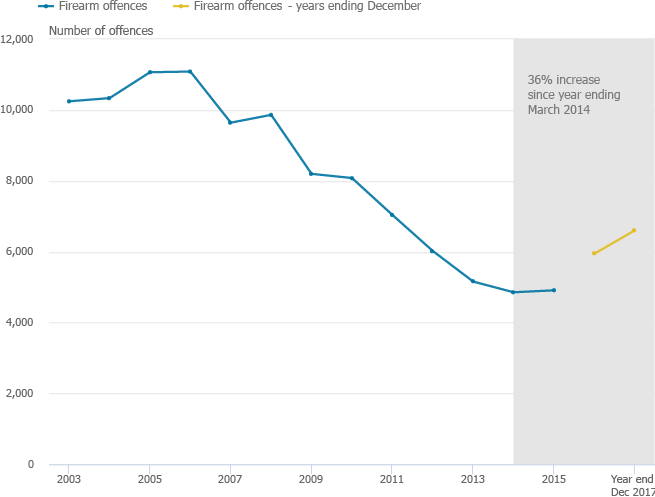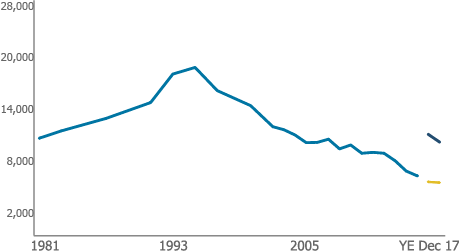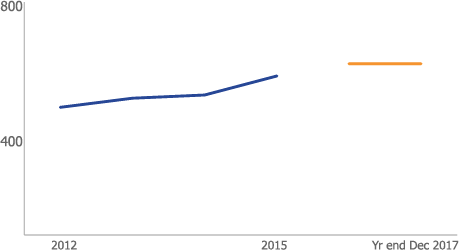Weapons Crime in England and Wales: year ending December 2017
Crime involving knives, guns, and other types of weapon.
Release date: 26 April 2018
Next release: 19 July 2018 (provisional)
This page is part of the latest release | View all pages in this release or view previous releases
Police recorded 7,130 (22%) more crimes involving weapons, with knife crime in cities rising most
England and Wales, year ending March 2011 to year ending December 2017

Source: Police recorded crime, Home Office
On this page you can:
- Get an overview of the main findings for weapons crime
- Get the data
- Learn how we measure these statistics
- Read a glossary of terms
- Find more pages in this release
- Contact us
Main findings for weapons crime
Knife crime reaches a seven-year-high
The police recorded 39,598 offences involving a knife or sharp instrument in the year ending December 2017. This is a 22% increase compared with the previous year (32,468), and the highest number in the seven-years' of available data.
The past three years have seen a rise in the number of recorded crimes involving a knife or sharp instrument. Before this, we saw a general downward trend since the year ending March 2011.
"Assault with injury" and "assault with intent to cause serious harm" made up around half (49%) of all crimes involving a knife or sharp instrument. All categories of weapons crime for which we collect data showed increases.
London's Metropolitan Police saw the largest increase (accounting for 48% of the total increase).
Admissions data for NHS hospitals in England shows a 7% increase in assault by a sharp object. Rising from 4,054 in the year ending March 2016 to 4,351 in the following 12 months.
Possession of a blade or point also rose
Police recorded "possession of an article with a blade or point" offences also rose, by 33%, to 17,437 offences. This is consistent with increases seen over the last four years, and the highest figure since the series began in the year ending March 2009.
Firearm crimes have increased for the first time since 2005
Police recorded firearms offences have increased over the last three years
England and Wales, year ending March 2003 to year ending December 2017

Source: Police recorded crime, Home Office
Notes:
- Police recorded crime data are not designated as National Statistics.
- Firearms include: shotguns; handguns; rifles; imitation weapons such as BB guns or soft air weapons; other weapons such as CS gas, pepper spray and stun guns; and unidentified weapons. They exclude conventional air weapons, such as air rifles.
Download this chart
Offences involving firearms increased by 11% (to 6,604) in the year ending December 2017, compared with the previous year (5,945 offences).
Police recorded a:
- 12% increase in offences involving handguns (accounting for 46% of the overall increase)
- 21% increase in offences involving unidentified firearms
- 20% increase in offences involving shotguns
- NHS England hospital admissions data also shows increases firearm injuries. This rose from 109 admissions in the year ending March 2016 to 135 admissions in the year ending March 2017.
London's Air Ambulance Data also suggest an increase in serious offences involving a weapon. In 2017, injuries resulting from stabbings and shootings were the most common cause for a helicopter to be dispatched.
Get the data
This bulletin mainly reports on data from two sources of crime data: the Crime Survey for England and Wales (CSEW) and police recorded crime.
More information on both these sources can be found in the User guide to crime statistics for England and Wales.
More about the data used in this bulletin
Further analysis on offences involving knives or sharp instruments and firearms can be found in Offences involving the use of weapons: data tables. This includes figures based on a broader definition of the types of firearm involved, such as air rifles.
See Homicide in England and Wales: Appendix tables for more information on homicides committed using a knife or sharp instrument.
There are some other categories of Police Recorded Crime data which can be broken down by whether or not a firearm, knife or sharp instrument was involved.
- Homicide
- Attempted murder
- Threats to kill
- Assault with injury and assault with intent to cause serious harm
- Robbery
- Rape
- Sexual assault
The Focus on violent crime and sexual offences publication includes data on offences involving a knife or sharp instrument going back to the year ending March 2009.
A breakdown of offences for each police force and the time series for these data are published in the Home Office’s knife crime open data table.
Hospital admissions data are from NHS Hospital Admitted Patient Care Activity, 2015 to 2016 and NHS Hospital Admitted Patient Care Activity, 2016 to 2017.
Recently published data by London’s Air Ambulance Data are from London’s Air Ambulance Mission Maps 2017.
Information about these statistics
More pages in this release

Crime in England and Wales
Over the long-term, crime has fallen, but some crimes have risen slightly in the previous 12 months.
Released: 26 April 2018

Fraud in England and Wales
No change in the volume of fraud offences in the last year
Released: 26 April 2018

Violent crime in England and Wales
Little change in levels of violent crime in recent years.
Released: 26 April 2018

